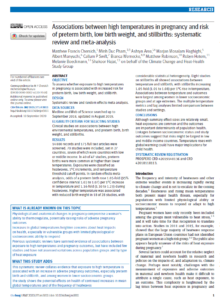
Objective To assess whether exposure to high temperatures in pregnancy is associated with increased risk for preterm birth, low birth weight, and stillbirth.
Design Systematic review and random effects meta-analysis.
Data sources Medline and Web of Science searched up to September 2018, updated in August 2019.
Eligibility criteria for selecting studies Clinical studies on associations between high environmental temperatures, and preterm birth, birth weight, and stillbirths.
Results 14 880 records and 175 full text articles were screened. 70 studies were included, set in 27 countries, seven of which were countries with low or middle income. In 40 of 47 studies, preterm births were more common at higher than lower temperatures. Exposures were classified as heatwaves, 1°C increments, and temperature threshold cutoff points. In random effects meta-analysis, odds of a preterm birth rose 1.05-fold (95% confidence interval 1.03 to 1.07) per 1°C increase in temperature and 1.16-fold (1.10 to 1.23) during heatwaves. Higher temperature was associated with reduced birth weight in 18 of 28 studies, with considerable statistical heterogeneity. Eight studies on stillbirths all showed associations between temperature and stillbirth, with stillbirths increasing 1.05-fold (1.01 to 1.08) per 1°C rise in temperature. Associations between temperature and outcomes were largest among women in lower socioeconomic groups and at age extremes. The multiple temperature metrics and lag analyses limited comparison between studies and settings.
Conclusions Although summary effect sizes are relatively small, heat exposures are common and the outcomes are important determinants of population health. Linkages between socioeconomic status and study outcomes suggest that risks might be largest in low and middle income countries. Temperature rises with global warming could have major implications for child health.